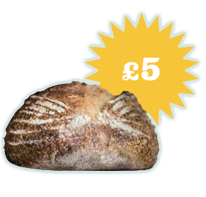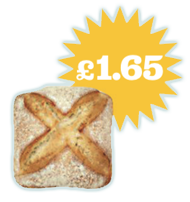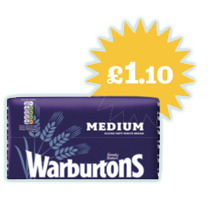At the Brick House Sourdough Bakery and Bar in Peckham Rye in south London, an 850g loaf of artisanal multigrain sourdough will set you back £5. Brick House loaves are handmade with organic flour, slow-fermented, naturally leavened and stone-baked over a period of around 48 hours in their converted east Dulwich warehouse. A former World Bread Award winner (in the coveted best baguette category), the baker also offers “sourdough in a day” classes for £150. The hum of commuters trundling into the train station next door, like the arrival of the bakery itself in 2017, reflects the rapid gentrification the area has undergone in the last decade. They do not accept cash.
Like many inner-city areas deemed to be “on the up,” Peckham is increasingly polarised. A five minute walk around the corner from Brick House, next to Poundstretcher, is a busy branch of Lidl, where an 800g loaf of sliced white bread costs 36p. These loaves are machine-made in one of Britain’s 150 large-plant bakeries in a process that takes only a few hours, thanks to the addition of flour treatment agent and emulsifiers. With the addition of the preservative calcium proponiate, the loaves will last on the shelves for a week or so.
We break bread with others as a gesture of friendship, as Jesus did with his disciples, so it might seem as if it should be a unifier in our culture, rather than a marker of difference. And yet if the loaf is becoming an icon of class division then history suggests that we should not be so surprised. As the most basic of foods, bread has been found on the frontline of social conflict, from the Roman Empire to 18th-century France and on to the Arab Spring. While no one has gone to war over an ice cream, in 1917 the Bolsheviks’ historic rallying cry was “peace, land and bread.”
If there is a battle of sorts over bread in Britain today, however, it is a battle with a twist. The most -zealous partisans are not hungry peasants about to storm barricades, overthrow governments or raid grain stores. They are middle-class foodies anxious about the industrialisation of food, keen to choose a loaf that demonstrates their discernment and taste for authenticity and perhaps suspecting that traditional baking can improve their health.
Has our fixation on speed, price and convenience destroyed bread’s taste and texture? Could it be that mass-produced long-life bread, shorn of the nutrients we’ve become used to over millennia, is giving us gluten sensitivities? Or could the new bread divide have more to do with snobbery than science? And, either way, is a return to ancient baking techniques the future?
Let them eat bread
From roti in Malaysia to injera in Ethiopia, from pumpernickel in Germany to sopaipilla in Chile, bread is as varied in shape, size and flavour as it is ubiquitous across the planet. Most of what we eat in contemporary Britain, however, is considerably more uniform. The supermarket fare known within the industry as the “wrapped loaf” is purchased by 97 per cent of the population, most of it made by the big three: Warburtons, Hovis and Kingsmill. The overwhelming majority of us are certainly not—and could not afford to be—in the habit of coughing up £5 for a hunk of slow-fermented, high-quality artisan sourdough.The origins of this uniformity go back over 70 years. When the screws were tightening during the Second World War, supply lines being severed, and rationing becoming more severe, the British government introduced a standardised National Loaf, made with wholemeal instead of white flour, with more of the grain, and added calcium and vitamins. It was grey-brown, heavier, more nutritious—and considerably less popular. When, after the war, to their relief, Britons were able to revert to white loaves again, experiments began in the addition of vitamins and minerals to the mixture.
The truly important change, though, came a little later—in 1961, in the small town of Chorleywood in Hertfordshire. This was the base for the microbiological and mechanical experiments of the British Baking Industries Research Association, and their epochal breakthrough that year became known as the Chorleywood Method. This method of baking bread used lower-protein wheat, more additives, vitamins, enzymes and yeast, and involved an ultra-high-speed mixing process. It turned out to be a lasting revolution. Cheap, plentiful and with a decent shelf life too, it was seen as—well—the best thing since sliced bread. At the last count, four British loaves in five still use the Chorleywood process.
But this is the kind of bread whose popularity is dipping, tarnished as inauthentic or indeed unhealthy. The Federation of Bakers, which represents the big baking companies, concede that there is a reputation problem regarding gut health, gluten -sensitivities and industrially produced “wrapped loaves.” “For some reason, there is an image that if you slice and wrap a loaf of bread, it becomes unhealthy,” the federation’s chief executive, Gordon Polson, tells me. “There isn’t really any evidence that suggests that all of a sudden, in the last five years, that if you’re eating bread, that it should cause you any problems.”
While “gluten free” has become a highly fashionable if little understood label to stick on all sorts of wheat-free food, it is obviously not something that can be said about traditional bread baked with wheat flour. To the extent that there is a health argument for sourdough, it is a more complex one, about problems produced by the extra refinement of Chorleywood-type processing. A typical “wrapped loaf” of sliced wholemeal, produced by one of the big three, contains 13 ingredients, including preservatives and emulsifiers. Sourdough requires just three: flour, water and salt.
Artisan evangelists argue that in sacrificing taste for shelf-life and a bargain basement price-point, the Chorleywood Method has also made bread less digestible, causing additional problems for people with Irritable Bowel Syndrome (IBS) and gluten sensitivities. The slow fermentation process that is absent from modern industrial bread-production changes the structure of the gluten, supposedly making it easier to digest than in wrapped supermarket loaves. It also lowers the glycemic index, preventing spikes in insulin and blood sugar, which is of benefit to people with diabetes. Some studies have suggested that the relatively higher presence of phytic acid in wrapped loaves impairs the body’s absorption of iron, zinc and calcium.
Polson scoffs at the idea that it could be making people ill. “If you bake bread in the UK, it’s all got to be produced under the bread and flour regulations. There’s no doubt, if you actually look at the scientific properties, and the nutritional properties of bread, it’s no different however it is made—from the sourdough to your standard sliced and wrapped bread.”
Polson’s implication is that there is a faddish tendency towards assuming serious gut health problems where there are none, and where there are serious gut problems, that production-line bread is responsible—but with no evidence. “If somebody has IBS, then of course they should be careful what they eat,” Polson continues, “but that includes all foods, not just bread. I sometimes feel like all the trials of the world are thrown at bread, and maybe that’s just because it is the one thing that pretty much everyone eats.”
An honest crust
This is the context in which a new-but-ancient pretender is not only challenging the wrapped loaf, but taking Britain by storm. Sourdough pizza chains like Franco Manca are thriving on the high street, the UK’s largest bakery chain Greggs is selling sourdough-flavoured snacks, and supermarkets are trying to get in on the artisan action.Unlike its artificially fortified cousin, real sourdough should be fermented and leavened over a matter of days, not hours, and contain only flour, water and the bubbling sourdough “starter,” a bacterially living dough-gloop of wild yeast and lactic acid that must be continually replenished. And while the health benefits might be debatable, it is beyond argument that eating it is a totally different experience. The dark, hard, chewy crust, spongy texture and beery tang of a loaf of fresh sourdough is barely the same species as the dry, bland, cotton-wool-like sliced white sold on the cheapest parts of the supermarket shelves.
The “real bread” backlash to Chorleywood loaves has bubbled up gradually, but picked up pace over the last few years. At its helm is Chris Young of the Real Bread Campaign, a lobby group founded a decade ago to represent and support artisan bakers and “proper” sourdough, and evangelise about what they see as the trickery and fakery of the supermarkets and the big three. For Young, peaceful co-existence with Big Bread is not one of the options on the table. He sees the industry as aggressors, jealously aping the success of the artisans, and attempting to squeeze them out. “In most cases they’re doing little more than appropriating the imagery and the language of the small independent bakers.”
The co-option of sourdough’s popularity, and of terms like “wholegrain,” “heritage grains” and “ancient grains,” which all lack a legal definition, misleads consumers, Young argues—and worse, it sullies the trusted reputation for quality of the artisan bakers. Terminology is the frontline of the battle. Young won’t even permit his opponents use of the “b” word: they are “industrial loaf fabricators,” not breadmakers. “The industrial white sliced loaf is still the market leader, but it doesn’t deserve the name ‘bread,’” he says.
“We are seeing products being named and marketed using the word ‘sourdough,’ where they’re not using a live sourdough starter culture. We’re seeing companies calling their products ‘artisan bread’ or an ‘artisan bakery,’ and yet it’s stuff that’s being banged out of a production line, with not a genuine skilled artisan baker in sight. You’re seeing things being sold as ‘freshly baked’ that actually were manufactured in an industrial unit, at some point in the past, sometimes at a distance, too.” He cites the example of a British high street sandwich chain selling a “fresh baguette” that was actually made in France, then frozen, with a shelf life of 12 months before it needed to be defrosted.
This “sourdough” vs “sourfaux” fight has led the Real Bread Campaign to call for parliament to tighten existing regulations and pass an Honest Crust Act, giving a legal definition to sourdough, along with “fresh,” “artisan,” “craft,” “wholegrain” and “heritage wheat.” It reached parliament in July last year, backed by 12 MPs, but was rejected by then-Defra Minister (and Brexit advocate) George Eustice, who replied that European regulations on labelling and advertising, and breadmakers’ use of fortifying nutrients, were perfectly adequate.
Great British fake-off
Class has intruded on British bread since long before the latest artisan craze. A generation ago, white sliced was working class, wholemeal was middle class. One friend in his 30s, raised vegetarian by a health-conscious middle-class liberal mum, was never allowed to have fluffy white sliced bread—and consequently eats it with rebellious gusto as an adult.Perhaps the real change is simply that the choices involved have multiplied. And some shoppers navigate them in complex ways. Gordon Polson is probably right when he says that, for many Britons, a fancy artisan loaf versus a pack of supermarket white sliced is not a battle where you choose your side and stick religiously to it. Many consumers will switch from the latter during the week, for toast in the morning, sandwiches for packed lunches and so on, to something a bit more pricey, with a shorter shelf life, at the weekend. “I think that’s where we’re seeing an increase in that market, rather than it being a direct substitution,” Polson says. “But we have to be honest here: not many of us are going to be able to buy a loaf of bread that costs £5.”
It is strikingly difficult for artisan bakers to shake off the elitist tag, a marked contrast with, say, the rapid progress of craft beer into mainstream pubs and supermarket chains. Chris Young is certainly familiar with the arguments over class, but registers bafflement at why high-quality bread should be treated as so much more of an unwarranted indulgence than good quality coffee, wine or cheese.
Perhaps it is to do with resentment at the gentrification of the most basic staple, a filler that most of us eat without any thought, an attitude that pains Young. “I suspect for a lot of people it’s not even conscious, they look at two options, think ‘I just want something to keep my fingers dry when I’m eating a sandwich,’ and choose the loaf that’s 50p-£1, rather than £4, because it’s just not a priority for them.” “The number of times I’ve been at a food festival or a farmers’ market, and they have, say, a lovingly reared rare-breed pig, and they’ve crafted the finest bacon on earth from it—but then they just bang it in some pappy bap from the wholesale van. It’s like framing the Mona Lisa in something from the pound shop. That’s two-thirds of the sandwich!”
But with some of the taste and sophisticated appeal of artisan bread but at less than half the price, it’s easy to see why the compromise of supermarket “sourfaux” is doing well. Young drips with contempt for what he calls the supermarkets’ in-store bakeries, calling them “loaf tanning salons” or “the great British fake-off.”
Authenticity is an essential attribute in contemporary food culture. Or rather, the appearance of authenticity—because the authenticity needn’t actually be authentic. Supermarkets have co-opted the more rustic aesthetics of the bouji artisan baker, refining the retail theatre of the in-store bakery, half-open to the customers, the smell wafting through the aisles, the wooden shelving, the produce stocked in cloth-lined baskets. In 2012, Tesco let the daylight in on this magic. Announcing the -unveiling of a “friendlier artisan feel” to their 850 “new continental-look” in-store bakeries in a press release, the company’s bakery chief boasted they had created “the kind of atmosphere you’d find in an artisan bakery, with wooden shelves filled with a far bigger and better range of speciality breads…” If the real product is too pricey to sell, you can always sell the experience.
While the enthusiasm for sourdough and “real bread” continues to grow, most artisan bakers work on a single, small site, running a market stall, café or bakery. The question arises: is it possible to make the same high-quality artisan bread on a semi-industrial scale? Is it possible to scale up the artisanal process to the point where all of us could enjoy the very best stuff as our daily bread?
On the rise
You can smell the rich, yeasty bacteria of the sourdough as soon as you turn into Western Road in northeast London. Wedged between a very 21st-century array of neighbours—a recycling centre, a Victorian-built primary school, an evangelical church and a co-working space—and housed in what was once a chocolate factory, Celtic Bakers are one of the largest artisanal bakers in the country, employing 130 staff, with Waitrose, Ocado and major cafe chains and caterers among their clients.Inside their factory are four huge tanks of sourdough “starter,” as well as thousands of kilos of specialist organic flour. Just like the starter of an enthusiastic home baker, the fragrant, bacterial gloop inside these tanks is never allowed to fall below a certain level—it is regularly refreshed (or “fed”) and carefully monitored, along with the ambient temperature in the room. Celtic Bakers MD Toby Mitchell lifts the lid on an organic rye sourdough starter which, with all the replenishment, is over 30 years old—it has the sweet, earthy aroma of a brewery. “It’s got the consistency of thick double cream, but the smell is almost fruity I think, a bit like banana, isn’t it incredible? It’s a living breathing thing, and all the life in the bread is coming from the air around it, from the bacteria. And in there, it’s just fire and water.”
Next door in the baking rooms, four bakers in white overalls stand across a modest-sized kneading table on which 10-12,000 loaves a day are stretched and sprung back, while another pair are rapidly scoring the sourdough loaves and shovelling them into ovens with gigantic metal spades, dozens at a time.
While they continue to expand operations, much of their equipment remains deliberately old fashioned—slow-moving mechanical forks for churning the dough, bakers’ cloths and straw baskets for resting. They tried an automated bagging machine for their sliced sourdough, but weren’t happy with how it handled the loaves, which are by their nature uneven in shape. Not everything can be standardised, Mitchell says, and not every tweak to improve efficiency is worth it.
While we talk amid the clamour of the machinery, one of the bakers takes a loaf out of the oven shelves, lifts it up, taps the bottom, frowns, and shows it to his colleague, before putting it back in. “Ah did you see that?” Mitchell says enthusiastically, from beneath the blue hairnet containing his beard and moustache: “That is exactly the kind of thing we don’t want to lose.” It is the art of the artisan: a keen human eye for those variables that an algorithm could never handle.
The price of a slice
Brick House Sourdough Handmade with organic flour, slow-fermented, naturally- leavened and stone-baked, over a period of 48 hours in a converted east Dulwich warehouse
![article body image]()
![article body image]()
Sainsbury's "Taste the Difference" Sourdough With 14 ingredients rather than three, this is an example of what Big Bread’s opponents would dismiss as “sourfaux”
![article body image]()
Warburtons medium sliced white bread Britain’s biggest bread company—retail analyst Kantor claims around 85 per cent of Britons regularly buy a Warburtons loaf. Its medium sliced white bread is one of the most popular
Aldi “Everyday essentials” white bread The 800g loaf is described by Aldi as “great for sandwiches” and is the cheapest loaf available on the high street
![article body image]()
Use your loaf
American author Michael Pollan, in his essay-like Netflix series Cooked, encourages us to take a step back, and take the long view on the most humble of foodstuffs. “The technology of baking bread represents a revolutionary advance for our species,” he says at one point, considering its early innovators, millennia ago. It is tempting to see bread as a kind of dazzling alchemy: from just flour and water comes this sustenance of human life. But beyond its apparent mysticism, it is also, as Pollan says, a technological and scientific achievement, and a testament to human civilisation: the grain needs to be cultivated, harvested and milled, before the actual breadmaking begins.That one of the biggest scientific leaps forwards—or backwards, depending on your view—came as late in bread’s history as 1961, and in a place as inconspicuous as Chorleywood, is remarkable. This epochal transformation of millennia of baking tradition was, perhaps, bound to run into a reaction.
But here in Britain, of course, bread is part of a much wider discussion. A country with the fifth highest GDP in the world should be able to afford to spend a bit more per head on its food—but instead bargain basement groceries and foodbanks are a sad necessity for millions. The battle over bread goes to the heart of our debate about what sort of country we want to live in.
Perhaps our food shouldn’t be nauseatingly cheap. Perhaps a whole chicken shouldn’t cost £2.39. Perhaps milk shouldn’t cost £1.09 for four pints. And perhaps a 800g loaf of bread shouldn’t cost 36p. But any debate on food, price, quality and class is bound to be fraught.
Better bread is a desirable thing. In today’s Britain, however, it’s not an easy discussion to have. Because too many are still grappling with that ancient dilemma of how they’re going to put bread on the table.

















